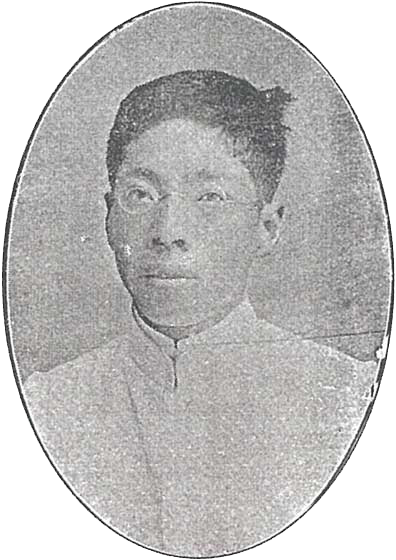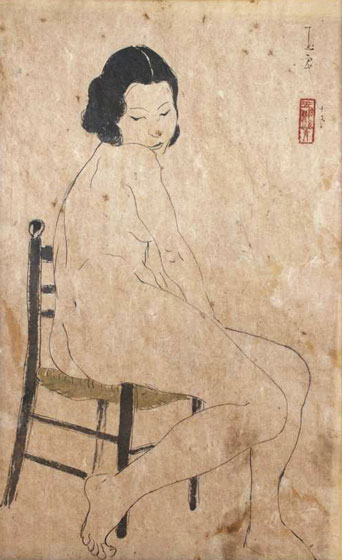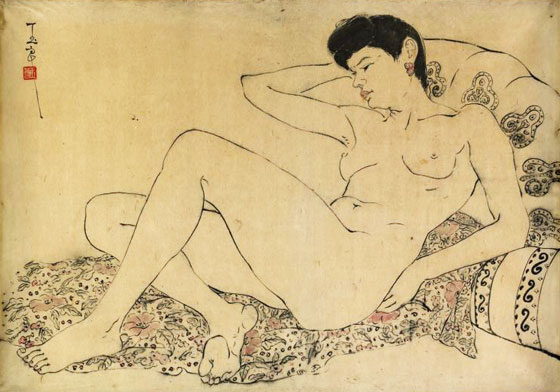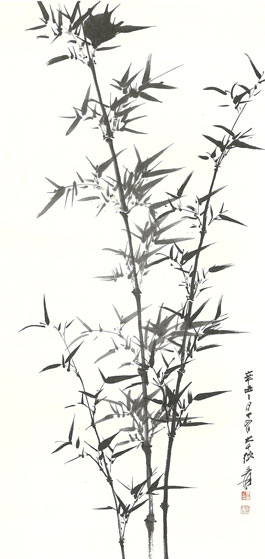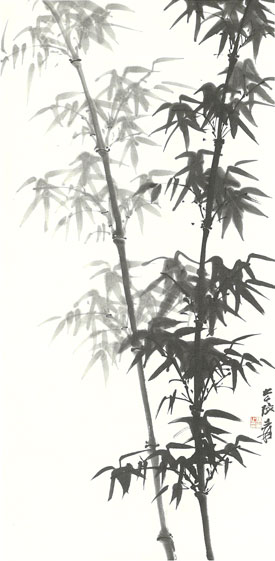Chronology
Born in Yangzhou, China, on 14 June as Zhang Shixiu, with yulin as her zi, or courtesy name.[1]After her marriage to Pan Zanhua, she changed her surname to Pan so that when she enrolled in the Shanghai Arts Academy, her name was Pan Shixiu.[2]It was not until she traveled to France that she started using the name Pan Yu Lin.[3]
Pan’s mother passed away when she was eight and as her father had already passed away when she was one, her uncle became her guardian.[4]
It has been said that Pan was sold into a brothel by her uncle. According to Su Xuelin, this led to controversy among students traveling to France to attend the Institut Franco-Chinois.[5]Pan’s friend Lin Ai believed she was sold as a servant, not a prostitute.[6]
Married Pan Zanhua and change her surname to Pan.[7]Zanhua, ten years her senior, had a wife in his hometown.[8]He studied in Japan in his early years and attended Xingzhong Hui (Revive China Society) and Tungmeng Hui (Revolutionary Alliance) organized by Sun Yat-sen. It is known that they got married in Wuhu, Anhui,[9]and Zanhua served as the supervisor in the customs office in Wuhu from 1912–1913.[10]It is therefore reasonable to assume they married during this period.
—
After their marriage, Zanhua left Wuhu in 1913[11]and became even more politically involved and travelled extensively throughout China.[12]In 1916, Yu Lin and Zanhua lived in Beijing, where she received school education[13]and a year later, the couple left Beijing for Shanghai.[14]
—
Started to learn painting and met Hong Ye,[16]her most important teacher during the formative years, who taught at the Shanghai Pictorial Art Academy.[15]
With the support of Zanhua and Hong Ye, Pan gained entry to Western Painting Department, the Shanghai Arts Academy.[17]When enrolled, she used Pan Shixiu as her name. Her class was the first co-ed class not only of the Shanghai Arts Academy, but of any higher education in art in China, as well.[18]
—
While at the Shanghai Arts Academy, Pan was active in school activities, including giving speeches, participating in Peking opera performances[19]and traveling with classmates to Hangzhou for practice in outdoor sketching, the first of its kind involving both male and female students[21]and were led by teachers Liu Haisu, Wang Jiyuan and Wang Yachen.[20]
—
Pan arranged for Zanhua’s first wife, Fang Shanyu, to move to Shanghai to live together with them. Fang gave birth to their son Pan Mou the following year.[22]
In March, members of the Heavenly Horse Society held a farewell dinner for Jiang Xiaojian and Chen Xiaojiang who were departing for studies in Europe. Pan attended this event and gave a congratulatory speech.[23]
—
In July, Pan withdrew from the Shanghai Arts Academy.[24]The Pan biographer, Dong Song, surmises that shortly after Pan enrolled, it was discovered that she had worked at a brothel. To appease the students who were exerting pressure for the school to expel her, school authorities requested that she withdraw. She complied.[25]
—
In the same month, Pan was accepted by the Institut Franco-Chinois in Lyon, France.[26]The Institut Franco-Chinois, also known as the Lyon Sino-Franco College, was founded by Wu Zhihui, Li Shizeng and Cai Yuanpei. The main purpose of this college was “to provide French language classes for Chinese students coming to France to study”. Once students mastered basic French, they could go on to other professional schools. The school, founded in 1921, was terminated in 1947 due to insufficient funds.[27]
continued
On 13 August, Wu Zhihui, principal of the Institut Franco-Chinois, and over 100 students, including Pan, embarked the Porthos liner from Shanghai to Marseille, arriving on 23 September. They arrived at Lyon by train the next day.[28]When Pan enrolled at the Institut, the name she used was Pan Yu Lin and she marked that she was single.[29]
—
During the first semester at the Institut, Pan met Su Xuelin and Fang Junbi.[30]According to Su, Pan took French language class in China for about one year, and was quite fluent when she enrolled at the Institut. While studying at the Institut, Pan did not have much interaction with fellow students in Lyon. When she returned to China, Su attended her first solo exhibition. Aside from this, the two lost contact for a while and it was not until the end of 1950 when Su went to France from Hong Kong that she saw Pan again. At this time, the two forged a stronger friendship.[31]
—
Took drawing and painting classes at the École nationale supérieure des beaux-arts de Lyon.[32]
Travelled to Paris to study art at the studio of Lucien Simon,[33]who was an associate of Salon de la société nationale des beaux-arts in France since 1890s and started teaching at École nationale supérieure des beaux-arts de Paris since 1923, playing a vital role in the academic studies of art.[34]
—
On 17 October, the Institut Franco-Chinois sent her an official disenrollment notification because she went to another institution to take classes that were available at the Institut, thereby violating their regulation. As a result of negotiations which lasted over six months, however, Pan retained her status at the Institut.[35]
In June, Pan received a letter of acceptance to the École nationale supérieure des beaux-arts de Paris,[36]where she studied for the next two years. She was classmates with Fang Junbi and Qiu Daiming.
—
Became acquainted with various people of the Chinese art and cultural circles, such as Guo 0Youshou, Zhang Daofan and Sanyu.
At the start of the year, Pan informed the Institut of her intention to go to Rome to study sculpture and painting and wished to retain her status at the Institut during this time, which was granted her.[37]In Italy, she received a scholarship of 5,000 lira from the Italian government.[38]
1926In June, Pan asked Qiu Daiming and Lin Baoquan, her classmates at the Institut Franco-Chinois, to ship a few hundred of her works back home to China. A fire broke out in the cargo hold, destroying all her paintings.[39]
—
Participated in The International Art Exposition in Rome, and won a gold medal.[40]
Returned to Shanghai with a certificate from the Accademia di Belle Arti di Roma and reunited with Zanhua. At that time Zanhua was the second chief of Farming Division, Ministry of Farming and Mining at the Nanjing National Government.[41]According to Su Xuelin, the couple owned a house in Shanghai.[42]
—
Pan was appointed dean of Western Painting Department at the Shanghai Arts Academy for one semester.[43]Pan had several positions at the academy in following years: 1932 as Western paintings advisor of the graduate school;[44]1934 as lecturer of summer training seminar for art teachers of primary and secondary schools;[45]1935 as instructor of the graduate level in Western painting;[46]1936 as graduate school professor and dean of painting;[47]from 1935 to 1936 as a member of the graduation exam committee.[48]
continued
Held her first solo exhibition at the Ningbo Townsmen Association in Shanghai from 28 November to 2 December, exhibiting 80 works that were mostly done during her years in Rome.[49]The Ningbo Townsmen Association, or Ningbo Townsmen in Shanghai Association, was one of the most important business organizations of modern Shanghai. The Association’s headquarters in central Shanghai[50]was inaugurated in 1921 and was a popular venue for art exhibitions.

In February, Pan was appointed dean of Western Painting Department, Shanghai Art College and taught for one semester.[51]
—
Joined Yiyuan Painting Research Center founded by Jiang Xiaojian, Wang Jiyuan and other artists.[52]
—
Pastels Geba, Narcissism and Reclining Man, as well as oil paintings Drunkard and Black Woman were exhibited at the first National Art Exhibition of the Republic of China organized by Ministry of Education, R.O.C in April, making a total of five pieces.[53]
—
In June, the organizing committee of the West Lake Expo requested works from members of the Yiyuan Art Academy. Contributing artists included Pan Yu Lin, Wang Jiyuan, Chen Chengbo, Tang Yunyu and Zhang Xian, with 32 works in total.[54]
continued
In October, travelled to Japan to study art education with the director of the Shanghai Jingye School’s Art Department, Jin Qijing, and fellow artist Wang Jiyuan. While in Japan, Pan held a solo exhibition at Shiseido in Ginza.[55]
—
Started teaching at the Art Department, College of Education of Central University in Nanjing.[56]From March 1929 to July 1930 and from December 1932 to July 1935, Pan served as lecturer;[57]from August 1931 to 1932 as adjunct associate professor.[58]Her students include Fei Cheng-Wu, Chang Chien-Ying etc. During this period, Pan actively participated in art exhibitions. In addition, she frequently took students out for outdoor sketching and touring, most notable of which was one trip in 1931 with Xu Beihong to Shandong, Tianjin and Beijing to visit Temple and Cemetery of Confucius, to climb up Taishan, as well as a visit to Forbidden City and the Great Wall. During this trip, they visited Kong Decheng, a 77th generation descendant of Confucius in the main lineage and Qi Baishi, the renowned artist.[59]
Became professor of Sculpture Department, Xinhua Art College.[60]This was the first time for Pan to teach sculpture since her return to China.
Pan’s painting My Family was shown at an art exhibition at the Science and Art Society of China in Shanghai from 1 to 7 August.[61]The Science and Art Society of China and its predecessor Bingchen Society were among the most important academic organizations of the early 20th century. Established in 1916 in Tokyo, Bingchen Society consisted primarily of students who studied in Japan. In 1923, Bingchen Society changed its name to the Science and Art Society of China, set its headquarters in Shanghai and became an important center for art activities in Shanghai.[62]
—
Moshe (摩社) held its inaugural meeting at the Science and Art Society of China in the same month and Pan was one of the founding members, along with Liu Haisu, Wang Jiyuan, Guan Liang, Fu Lei, Zhou Shoujuan and Pang Hiun Kin (Pang Xunqin).[63]
Founded the Chinese Art Society in Nanjing with Zhang Daofan, Wang Qi, Li Yishi and other artists, with Zhang Daofan acting as Secretary-General.[64]Elected the next year as a member of the Society’s 2nd executive committee and also helped manage its public relations.[65]From 1934 to 1936, Pan participated in exhibitions of the Society five times.[66]
Underwent an operation for a nasal condition that would plague her for the rest of her life.[67]
—
In April, the first volume of A Collection of Paintings by Pan Yu Lin, comprising 23 works, was published by the Shanghai Chung Hwa Book Company.[68]
—
In June, the first exhibition of Yifeng was held at Science and Art Society of China, Shanghai. Artists from National Central University, such as Xu Beihong, Pan Yu Lin, Gu Liaoran, Chen Zhifo and Li Yishi, as well as their counterparts from National Hangzhou Arts Academy, such as Lin Fengmian, Cai Weilian and Wu Dayu, participated in the exhibition and over 900 works were exhibited, making it the largest non-governmental art exhibition ever.[69]
—
In November, inaugurated China-Italy Cultural Association in Nanjing with Teng Gu, Xu Beihong, Jiang Biwei, Xie Shoukang, Jiang Fucong, Guo Youshou and Lv Sibai, etc. With the support of the Italian ambassador to China, the association was officially set up the following year to promote cultural exchanges between the two nations.[70]
After Pan resigned from the National Central University, she travelled across southern China.
—
In October, the Ministry of Education made a selection of Pan’s works and sent it to the International Art Exhibition in Australia.[71]
In February, Liu Haisu and others organized a banquet at the International Hotel in Shanghai to celebrate the 70th birthday of Cai Yuanpei, director of the Academia Sinica. Pan was among the approximately 120 guests.[72]
—
In March, launched Zhonghua Art Association in Shanghai with Liu Haisu, Ni Yide, Wang Jiyuan and others. Pan was elected Director of the first board.[73]
—
From 19 to 21 June, participated in the first Moshe (默社) Painting exhibition held at the Shanghai Youth Club.[74]Moshe was an art association founded by Xu Beihong, Wang Yachen, Chen Baoyi and others which attracted a number of renowned artists.[75]
In April, founded the National Art Society together with Lin Fengmian, Liu Haisu, Chu Minyi and Zhang Daofan, etc.[76]
—
From 10 to 13 June, the China Arts Association and the China Arts and Literature Society jointly organized An Exhibition of Paintings by Pan Yu Lin at the Overseas Chinese Club in Nanjing. This was Pan’s fourth and last solo exhibition in China during her lifetime. 170 works were shown and the exhibition was well attended. Chen Duxiu, still serving a prison sentence at the time, gave Pan’s ink painting Human Sketch a high mark. Zhang Daofan, Chang Renxia and others wrote favorable critiques in the Central Daily.[77]
—
On 26 July, Pan left Nanjing for Shanghai to embark on a boat to Siberia and to travel by way of the Soviet Union and Germany to France.
continued
Prior to the opening of her solo exhibition at the Overseas Chinese Club, Pan revealed she intended to travel to France. She felt she had accomplished little since returning to China ten years ago, and she therefore wished to travel to France, Italy, Greece and Holland to stimulate her creative energies. Pan had intended to stay in Europe for only two years.[78]The eruption of the World War II disrupted her plans of returning home. Until her death, she never returned to China.
—
In the fall, Pan set up residence in Paris. Her contact address was 13 rue de la Grande Chaumière.
In January, to assist women and children victimized by the Sino-Japanese War, the French Women’s Association held a lottery with Chinese art works as prizes. Pan and members of the Association des artistes chinois en France (AACF) helped with collecting art works and organizing the event. They also made donations at the New Year banquet in support of the war back home.[79]AACF was a group of Chinese artists living in France, who met regularly for social events and field trips. Its members included, in addition to Pan, Chang Shuhong, Hua Tianyou, Wu Guanzhong, Zhao Wuji, to name a few. Settled in Paris, Pan often took part in the activities of the organization.
—
From Jun 4 to Jul 3, five works were exhibited at Salon des Tuileries. This was her first salon exhibition since returning to Europe.[80]
Pan took refuge in the French countryside at the outbreak of World War II. Her exact date of return to Paris is unclear.[81]
In a letter dated 19 March to Zanhua, Yu Lin expressed concern over Pan Mou’s marriage. Due to the war, Zanhua didn’t receive the letter until 5 December, in which he replied, “You work hard. Your future is bright, and it is real and promising, not empty. How fortunate I am to help you in your success.”[82]Upon her return to Europe, Yu Lin and the Pan family communicated frequently. She and Zanhua kept their intimate relationship their entire lives.
—
In May, before the end of Salon de printemps, Leisure, an oil painting by Pan, was deliberately slashed. It is suspected a German soldier, whose troop occupied Paris at the time, wanted revenge for not being able to obtain the work at a lower price.[83]
One of Pan's ink drawings were bought by the Centre national des arts plastiques.[84]This is the first time the French government acquired a work by Pan. Four years later, the Centre acquired another ink drawing[85]and in 1958 commissioned Pan to make a bronze bust of the renowned educator Maria Montessori.[86]
—
According to the biographer Dong Song, Pan went to the Soviet Union this year and was welcomed for the local press.[87]
Salon exhibitions indicated that she moved to 3 rue Vercingétorix in the 14th.[88]
—
Formally became a member of the Association des artistes Chinois en France (AACF).[89]Chou Lin (Zhou Lin), scholar and Pan’s dealer, joined AACF at the same time.[90]
—
A Christmas Eve party was organized by the AACF and was held at the residence of Li Fengbai. Pan and others performed Peking Opera at the event.[91]
In March, elected as chairperson of the Association des artistes Chinois en France.[92]In November, due to unspecified health reasons, Pan left Paris for three months for the countryside and requested a six-month leave of absence from the AACF;[93]however by Christmas of the same year, she attended the AACF Christmas party held at Li Fengbai’s home.[94]
L’Exposition des Œuvres des Membres de l’Association des Artistes Chinois en France was held in Paris in October. Pan participated the exhibition with 35 oil paintings and drawings. Chou Lin, Hua Tianyou, Liao Xinxue and Li Fengbai also exhibited paintings and sculptures.[95]
—
The International Exhibition of Modern Art organized by UNESCO was held at the Palais de Tokyo in November. Pan, along with Zhang Daqian, Xu Beihong, Hua Tianyou and others, participated in the exhibition,[96]which was covered by a reporter from Shen Bao who visited Pan in her studio in Paris where he found Pan’s name in Chinese characters carved on a plaque hung at her front door. Around her name, many visitors, mostly artists, signed their names,[97]a testament to her role as a popular and significant member of the Chinese artists community in Paris.
Pan sculpted a bronze bust of her friend, Wang Shouyi, who became her close companion. According to Su Xuelin, Pan once commented that after the Second World War, selling sculpture earned more than paintings.[98]Her important sculptures include the busts of Maria Montessori,[99]Wang Shouyi,[100]Rene Grousset[101]and Zhang Daqian, as well as Coalminer commissioned by the shipping magnate Dong Haoyun.[102]
In October, the Embassy of the Republic of China held an exhibition of four Chinese artists who lived in France: Pan, Sanyu, Zhao Wuji and Xiao Lingzhuo. This exhibition drew high praise from French critics.[103]
Su Xuelin, Pan’s classmate from the Institut Franco-Chinois, arrived in Paris. The two friends, together with Fang Junbi, met at Pan’s studio after an absence of 20 years. The close friendship between Pan and Su would continue after Su settled in Taiwan and until Pan’s death.[104]
—
Due to political unrest, her family back in China suffered financially, but Pan managed to send money home.[105]
—
In 1950, 1951, 1952, 1955 and 1966, underwent several nasal operations,[106]afflicting her facial appearance.[107]
Made 42 linocut prints of varying subjects, 40 of which she divided into two albums with 20 prints each. Each album had cloth covers on which the characters diaoban huaji (Collection of Carved Prints) were hand-embroidered. After her death, Wang Shouyi donated the two albums to the Cernuschi Museum in Paris.[108]
—
Pan had a special relationship with the Cernuschi Museum. In 1954, Pan created a bronze bust of the former director, René Grousset, which she donated to the museum. In 1958, Guo Youshou and Chou Lin donated Nude to the museum. In 1981, the Embassy of the People’s Republic of China donated to the museum her Seated Woman in a Red Robe.[109]To date, aside from the Anhui Museum, which inherited most of her works after her death, the Cernuschi Museum has the largest collection of works by Pan.
From 23 May to 10 June, Pan held a solo exhibition at the Galerie d’Orsay. The 114 works shown included drawings, oil paintings and prints. The exhibition was organized by Les Éditions Euros owned by Chou Lin.[110]This is her first solo exhibition after return to Europe.
In spring, through Fei Cheng-wu and Chang Chien-Ying, an artist couple who settled in London, sent works to be exhibited at the Royal Academy of Arts. With their help, Pan participated in the RA exhibition in 1956, 1959 and 1961.[111]She also helped the couple participate in salon exhibitions in Paris.[112]
—
In June, Jean-Claude Bernard, a film director, went to Pan’s studio to make a short documentary[113]entitled Chez ceux du Montparnasse introducing the artists of Montparnasse. Pan and Tsuguharu Foujita were the only two Asian artists featured in this film.[114]
—
According to the artist Zhu Dequn, he saw Pan regularly at the Académie de la Grande Chaumière.[115]
—
Held an exhibition in Greece.[116]
In the spring, due to her poor health,[117]Zanhua advised her to return home. According to Zanhua, however, her art was regarded as property of France, meaning she could not bring them home. Unwilling to give up her works, she remained in France.[118]
—
In May, Zhang Daqian visited France and met Pan. Zhang gave his works Emotions and Lotus to Pan as presents.[119]Upon seeing her ink and color painting of Cat, he inscribed the painting with a colophon praising Pan’s skills.[120]In the same year, Pan completed the bronze bust of Zhang Daqian, which later became collection of City of Paris Museum of Modern Art.[121]In 1961, when he visited France again, Zhang gave Pan two paintings, both entitled Bamboo[122]and inscribed her painting Peony.[123]
Held a second solo exhibition at the Galerie d’Orsay from 22 May to 15 June entitled Pan Yu Lin : Œuvres Récentes.
1959Pan Zanhua passed away in August. Pan did not learn of this until the following year.[124]
Arrived in San Francisco in January to attend an exhibition of her works for which she received an award from the Chinese Chamber of Commerce of San Francisco.[125]
—
Traveled on to New York in April where the China Institute in America organized a solo exhibition entitled Chinese Artist Madame Yu-lin Pan of Paris for her at the China House. Vadim Elisseeff, director of the Cernuschi Museum, wrote the introduction for the exhibition catalogue.[126]Her only other exhibition in America would be four years later at the Wustum Museum of Fine Arts in Racine, Wisconsin, entitled Modern Chinese Brushwork.[127]
—
Returned to Paris in June.
Official diplomatic relations established between the People’s Republic of China and France. Pan received invitation to attend the reception celebrating National Day at the Chinese embassy in France.[128]
1968In the letter of 22 November, Pan wrote about her high blood pressure to Su Xuelin, who had immigrated to Taiwan.[129]Due to her poor health, Pan was not able to paint most of the time in the following years and looked forward to returning home to reunite with her family.[130]During this time, she maintained close contact with many of her compatriots.
In the letter of September 17, she admitted to Pan Mou, “My body is so weak that I cannot go on a plane. When will I be able to enjoy the pleasures of home again?”[131]Maybe to comfort her family, she expressed relief that the French government gave her a good living subsidy in the same letter.
—
Interviewed by the Taiwan artist, Xi Song. At this time, Pan’s studio and living space was located in the art studio district of Monparnasse. At the time of the interview, Pan reminisced the glory of returning to China from Italy and expressed her desire to hold another such exhibition, now impossible due to her failing health.[132]This was most likely the Pan’s last interview before her death.
After two years of planning,[134]the Cernuschi Museum held the exhibition Four Contemporary Chinese Artists: Pan Yu Lin, Lam Oi (Lin Ai), Ou Seu-tan (Wu Sidan) and Shing Wai (Cheng Hui) from 26 March to 30 April, in which Pan showed 43 works.[135]Prior to this, Pan was hospitalized for two months as a result of a stomach ailment, but due to urban renewal plans, she had to leave the hospital to move. Her new address was 194 rue d’Alésia in the 14th arrondissement.[133]
—
On 22 July, Pan passed away in Paris at the age of 82. Her deathbed wishes to her friend Wang Shouyi was to be buried wearing a qipao and to have all her works shipped home to Anhui.[136]Her paintings were eventually shipped back to Anhui in 1984 and most of them are now housed in the Anhui Museum in Hefei.[137]


